What To Consider When Comparing LED Strip Lights
There are many different LED strips on the market, and deciding which one to choose can be difficult. Here, we tell you what information you should compare to buy the best lights for your project.
Buying LED Strip lights online is not an easy task, especially when you do not have much experience or knowledge of what you are looking for. There are numerous competing brands in a poorly standardized market, making it difficult for customers to understand which one to choose. To help clarify the situation, here are the main LED lighting properties to consider when comparing LED strip lights.

Lumens
Lumens (lm) measure the total amount of light emitted by a light source. In other words, lumens are a measurement of brightness. For LED strip lighting, the lumen output or brightness is usually provided in lumens per foot (lm/ft) or lumens per meter (lm/m). The number of lumens will tell you how much light will be produced by the LED strip light. To find the total amount of lumens produced by your installation, multiply the lumens per foot by how many feet of lights you’ll be rolling out.
Flexfire LEDs’ highest lumen output LED strip light is the UltraBright™ Industrial Series LED Strip Light, which emits up to 1,019 lumens per foot (3,344 lm/m).
Watts
Check the wattage to find out how much energy the LED strip light you are considering will use. LEDs are a highly efficient form of lighting, but depending on the manufacturer, some chips will use less energy than others. To see how efficient any light is, divide the amount of lumens produced by the number of watts it requires (“lumens per watt”).
Flexfire LEDs strip lights are highly efficient, with single color white strips achieving efficacy levels of over 140 lumens per watt.

Color Rendering Index (CRI)
Not all light is made equally; some light sources render color better than others. The Color Rendering Index (CRI) is a widely used metric that measures how accurately a light source displays colors. The CRI rating ranges from 0 to 100, with 100 indicating perfect color accuracy, meaning that colors under the light source appear the same as they would under natural sunlight. Lights with a CRI above 90 are considered “High CRI” lights.
Most white LED strip lights from Flexfire LEDs boast a CRI rating above 90. This has important applications for residential and commercial lighting projects, where color fidelity is key.
Correlated Color Temperature (CCT)
Color temperature, measured in Kelvins (K), is used to determine what color wavelengths are emitted from a “white” light. A “cool” temperature light (4,500-6,500K) is composed primarily of the blue portion of the light spectrum with wavelengths that approach ultraviolet radiation. “Warm” temperature lights (2,700-3,200K) will appear with more yellow and orange tones, a light quality more consistent with the conventional incandescent light bulb.
Where and how you will use the lights determines which color temperature you should choose. Each color and light temperature has a unique psychological impact; warm, yellowish lights will leave you feeling more relaxed, while cool, bluish lights will make you more alert and productive. At Flexfire LEDs, you will find a wide range of CCTs that range from a warm 2700K white light to a cool 5000K white light.


IP Rating
The IP rating refers to how well a light is protected from liquids and solids. An IP rating comprises two numbers; the first refers to protection against solid objects and goes from 0 to 6, while the second refers to protection against liquids and goes from 0 to 8. A fully solid and waterproofed strip light would have an IP68 rating.
This is a critical feature when choosing a strip light for outdoor or wet location applications. If you are installing an LED strip light in a humid or high moisture environment, using an IP65 rating is recommended. Our Outdoor UltraBright™ Architectural Series is a popular option due to its high lumen output and ability to function in long run installations.
LED Chip Type or LED Chips per Foot
Informed LED strip light purchasers should also pay attention to the number of LED chips per foot and the type of LED chip on the reel. LED strip lighting is produced using a variety of chip types. Looking at different products, you might find identifications such as 3528 SMD or 5050 SMD. What’s the difference? Those numbers refer to the size of the chip as measured in millimeters. For example, 5050 SMD LED chips measure 5.0 mm by 5.0 mm.
While a larger chip will generally mean a higher light output, it’s also important to consider how many chips are on the reel. For instance, a strip that uses 3528 SMD chips may be brighter than a 5050 SMD strip light because more chips are packed onto the reel.
Get Expert Guidance and Start Your Project
The terms above are just the basics for comparing LED strip lights, but there are other factors to consider. Do you need dimmable LED strips? What color suits your project best? Are you looking for color-changing LED options? Our design specialists are here to help answer these questions and guide you toward the perfect solution.
Ready to get started? Whether you’re looking for LED strip lights, dimmers, or controllers, visit us at Flexfireleds.com or call us at 1-844-FLEXFIRE. Let’s bring your lighting vision to life today!



